Development of the P210 began in 1937, when Sig purchased the rights to French designer Charles Petter’s Modele 1935A pistol (anyone who has handled both will notice the similarity). This had been adopted by the French army in the 7.65 Long caliber, and Sig began by changing it to 9mm Luger. They also moved the safety down onto the frame of the pistol, and replaced Petter’s barrel linkage with a milled cutout integral to the barrel.
Sig had prototypes ready for testing by 1944, with both single stack and double stack magazine variants. The Swiss military decided that the double stack pistols were less comfortable to hold and thus less accurate in practice, and decided on the single stack model. However, World War II ended before they formally accepted a design and the acquisition program was ended. Mechanically, the pistol is basically of the Browning system, with a short recoil, tilting barrel. The unusual aspects are the slide riding inside the frame, the use of a modular and easily removed fire control group, and the exceptional fitting and tolerances.
The pistol was revived in 1947 through the interest of Swiss target shooters and the Danish Army, and production began that year under the designation SP (Sig-Petter) 47/8. The Swiss government took another look at the design, and finally adopted it in 1949, at which time the P210 name was also formalized. The SP 47/8 and P210 differ in a few details, namely the P210 not having a loaded chamber indicator.
While the military contracts were all in 9mm Luger, commercial sales also included guns chambered for .30 Luger (7.65x21mm). Over the years, a number of variants of the P210 were released:
P210-1: Standard pistol with fixed sights, blued finish and wood grips (used by Swiss police)
P210-2: Same as the -1, but with plastic grips and a parkerized finish. Later Swiss issue pistols were of this type.
P210-3: Same as the -1 or -2 but with the early loaded chamber indicator fitted (not a common variant).
P210-4: Same as the -1 or -2, but without a lanyard loop on the grip. This model was sold to the German border guard, and will have a serial number beginning with a “D”.
P210-5: A target version, with a longer 6″ (150mm) barrel and barrel-mounted front sight. Also uses a heavier frame and adjustable rear sight.
P210-6: Widespread standard-length (120mm/4.75″) target pistol with fixed sights.
P210-7: Standalone .22LR version (the .22 adapter could also be purchased as just a slide assembly for use with an existing frame)
P210-8: Recent re-released version produced beginning in 2003. These use a push-button magazine release instead of the original heel release, as well as the heavy target frame and do not have a magazine safety.
Manuals & Brochures
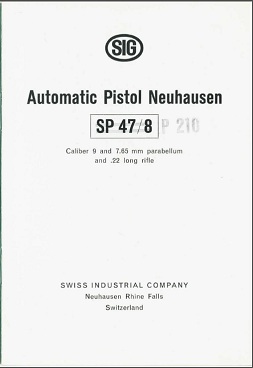
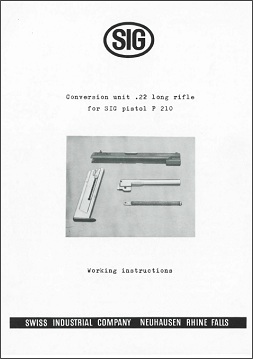
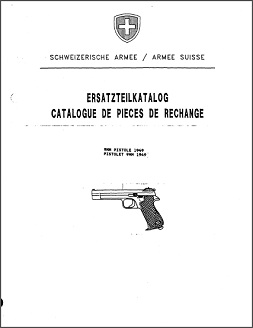
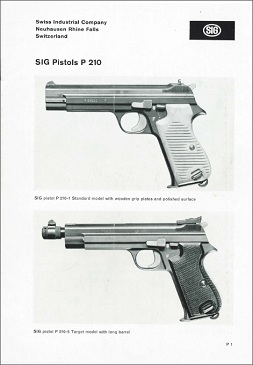
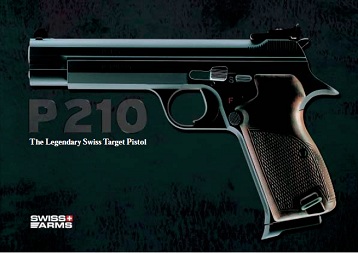
Resources
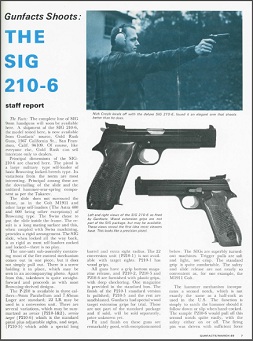

There is nothing unusual about the slide riding inside the frame, given the precedent of the Luger in the Swiss military service, which features just this arrangement of its receiver reciprocating inside the frame rails. Note also that Aimo Lahti likewise copied this feature in designing his eponymous L-35 that succeeded the Luger in the Finnish military service. Coincidentally, the L-35 and the P210 are the only service autopistols to approach the accuracy of the Luger.
The SIG brief of building a Browning-style, short recoil, swinging barrel autopistol with the accuracy of a Luger, inspired one key design improvement, whereby SIG engineers dispensed with the barrel swinging link, faithfully adapted from the M1911 Colt by Charles Petter, whose patents they used under license as the starting point for their P210 design. In the test prototype numbered 6004, SIG used two links pivoting around common upper and lower axes, for the sake of stabilizing the barrel trajectory during the cycling of the action. This costly and complicated arrangement was superseded in the test prototype numbered 6007, by incorporation of two precisely milled surfaces, a locking device slot (Verriegelungsnut), inspired by the corresponding features of the Radom Vis, and twin locking device curves (Verriegelungskurven), protected under Swiss Patent No. 270873. This arrangement eliminated lateral play during barrel movement in the short recoil cycle.
The SP 47/8 has no loaded chamber indicator, whereas the P210-3 and P210-4 variants incorporate it. Most P210-5 and P210-6 variants are built on a standard frame. SIG made about 300 heavy frame pistols in the forged frame production run, and a few hundred more with CNC milled frames. The standard finish on P210 variants is matte blue (oxidized), rather than Parkerizing (phosphated). More technical and historical details can be found in my survey articles.
Coincidentally the Luger isn’t ungodly accurate, that is an old wives tale. Put a Luger, L35, and P210 in a machine rest. I bet the P210 whether Swiss, German, or U.S. made shoots 1″ 50 yard groups with the right ammo. The L35 will likely come in second and the Luger third. Also the Luger doesn’t really have a slide per se so saying it’s like a P210, L35, CZ75 with the slide riding inside the frame isn’t really accurate. The Luger has a barrel extenion that rides inside the frame with a bolt/toggle that rides inside the barrel extension. It’s very much a different and Unique design, and while complicated it worked but the Luger was never considered to be a highly reliable pistol. The L35 and P210 on the other hand are.
Also I want to know what these CNC milled frames are milled from. Just because they are machined from a billet does not mean they can’t be forged. You cannot magically get a billet of steel it must either be forged or cast. Saying it is CNC machined says nothing of where the material came from it simply means it was machined on a computer controlled machine. And as an 8 year CNC operator I can tell you there are still plenty of machining operations that can be performed faster on conventional machines than they can on a CNC.
I have recently found forgottenweapons.com and it is unique and original. I want to thank the creator of the site… and Mr. Zeleny for an excellent link to his research on the p210 and much more. Happy New Year!
Is there any info on the longer version of the SP 47/8. It looks just like a Sig P210-5. Thanks.
Opportunity to purchase a Sig P210-2. I am looking for the year of manufacturer. It is a Sig P210-2 (Made in Switzerland, Sig Tysons Corner, VA) SN: P 3071NN. By chance can you give some assist?
Thanks in advance.
I apologize for my English.
SIG 210-1 is also used in the Danish armed forces. the test of SIG 210 was made in 1948 and then purchased. Here in Denmark called for 9mm pistol M / 49, unofficially, just Neuhausen pistol.
The gun is still in use today, but will be replaced by the H&K USP, when they break.
I just bought No. 12734, so it still works after 66 years.
My SIG P210 isn’t black but brown and has a mag release in the side. It has black grips. I think it’s a 1989 version but I don’t know for sure. Can you tell me what version could have?
Ricordo un dettaglio fondamentale.
Charles Petter era svizzero non francese.
Si dovette comperare il brevetto dalla Francia perché fu inventato su comanda da loro.